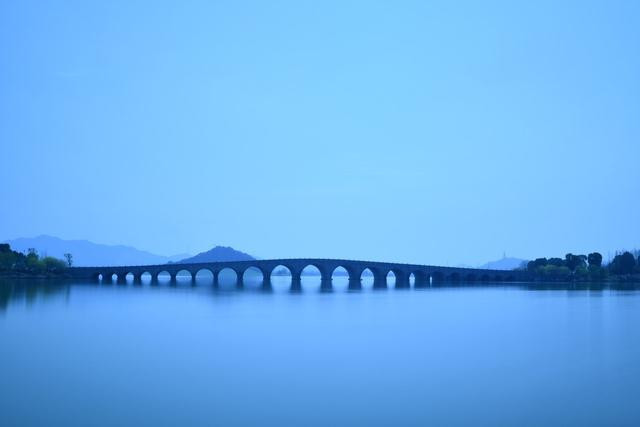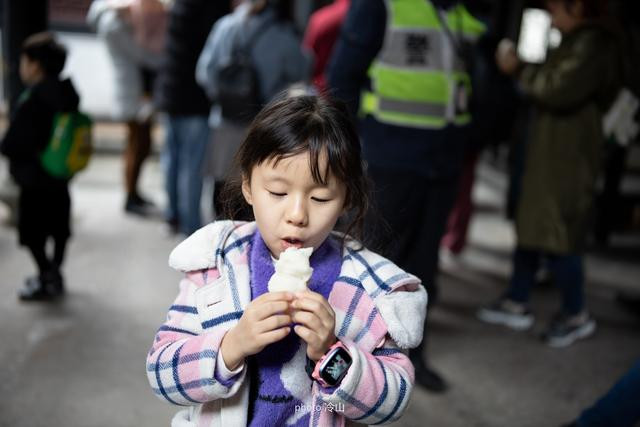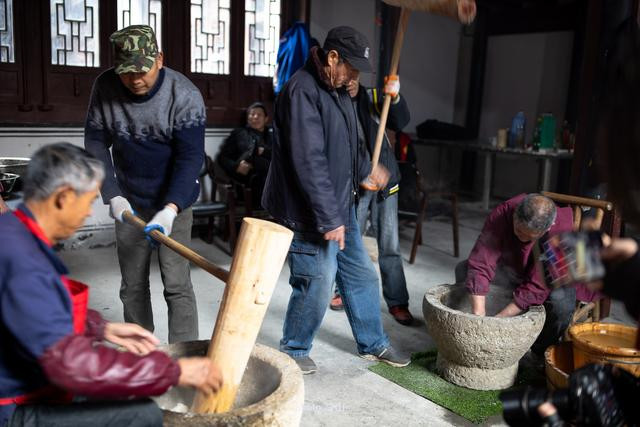Spring morning in Xiaoshan, walking children to check in Hangzhou New Year's Eve

Xianghu is misty and rainy with long green silk,
Slide wild rice into a new rice bowl on a spoon.
After the clouds dispersed, when the moon recedes,
When the tide falls, the boat is drunk and I don't know.
Lu You wrote this in "Fisherman: Xianghu Misty Rain and Long Silk". When people describe the beauty of the West Lake in the four seasons, they always think of "the water is shining and clear, and the mountains are strange and the sky is covered with rain." I think it would be appropriate to place this poem on Xianghu. The boat was sailing on the drizzling Xianghu Lake. In the distance, there was a misty rain painting on the bridge. Occasionally, birds flew across the water. It was as if time had gone back and returned to that simple and poetic year and month without smog. Xianghu Lake has the beauty of the West Lake, but it is less noisy than tourists. It is calm in the busy city.

On the west side of Xiaoshan City, in the blue mountains, there is a vast expanse of clear water, like a precious mirror left in the world by the celestial palace. It is clear and clear. Zhou Qixin, a poet of the Qing Dynasty, called it "Hanxu Tianjing Luoling Lake", this is Xianghu Lake. The 30,000-acre Xianghu Lake is known as the "sister lake" of the West Lake and is one of the birthplaces of Chinese civilization. The most distinctive building in Xianghu is the "Crossing Lake Bridge Ruins Museum". The entire museum building adopts a "boat" shape from plan to three-dimensional, as if a small boat is about to paddle towards a new building in the distance. The best way to visit Xianghu is to take a cruise ship, listen to the slowly told stories of the past of Xianghu on the smoke waves of Xianghu, and enjoy the beautiful scenery of Jiangnan.

On Xianghu, archaeologists have successively discovered the world's earliest canoes, the world's earliest lacquer bows, China's earliest "straw pot", China's earliest slow-wheel pottery making technology, China's earliest horizontal loom, China's earliest retort, the earliest domestic pig in South China, the earliest painted pottery in South China, the earliest cultivated rice in the lower reaches of the Yangtze River, and the earliest mat-like weaving fabric in the Jiangnan area. These discoveries have undoubtedly rewritten the history of civilization development in Hangzhou and even China.

Like West Lake, Xianghu was originally connected to the sea. In the second year of Zhenghe of the Song Dynasty (1112), Xiaoshan County Magistrate Yang Shi "looked at the mountains to follow, the land to be dug, the mountains as the boundary, and the soil to be a pond" before he built an artificial lake on the original site of Xicheng Lake. This is now the Hunan Lake. What impressed me most by boating on Xianghu Lake was the various bridges. From ancient times to the present, all of them told us about the vicissitudes of history and the beauty of the present.


At the end of the Spring and Autumn Period and the Warring States Period, the Xianghu area belonged to the territory of the State of Yue and was one of the main battlefields of the battle between Wu and Yue. Fan Li led his soldiers to fight it back with huge rocks on the top of the mountain. Wang Zheng of Yue, with its main peak at an altitude of 354 meters, now belongs to Shaoxing in the east and Xiaoshan in the west. The top of the mountain once had old sites such as "Zoumagang","Ambush Road","Zhigenlou", and "Xiaoyao Tian". It is said that they were relics of the Yue Army protecting this mountain, so the mountain is also known as "Yue Wang Mountain" and "Qi Mountain".

In spring in the south of the Yangtze River, we can't wait to come to Xianghu amidst the chilly winter. The hanging willows by the lake seem to have begun to bloom in spring without waiting for the red leaves to fall. How can such a Xianghu not attract people to linger?

As one of the earliest carriers of Chinese culture to the world, ceramics are also one of Xiaoshan's cultural symbols. On the bank of Hunan Lake, we came to the Zhejiang Province Museum of Modern Ceramic Art and began a wonderful journey to the museum that was full of harvest and interesting. In the 1990s, not only were many manufacturers unable to continue due to the exhaustion of clay resources, but the state also issued a ban on clay brick making, and brick factories were closed one after another. Zhejiang Province Museum of Modern Ceramic Art is an exhibition hall converted from a brick kiln factory that incorporates contemporary design concepts.

The museum has more than 350 valuable ceramic art works, most of which are painted ceramic artworks by masters of modern ceramic art and Chinese arts and crafts. They are rich in categories and in various forms, including: blue and white, underglaze red, new color, pastel, ancient color, etc., vividly interpreting the different shapes and technological characteristics of modern Chinese ceramics.


Chinese ceramics are not simply daily necessities, but also an art of life, integrating practicality with spiritual creation. Every year, the museum launches a rich and exciting personal exhibition of ceramic art masters, which displays the personalities and artistic styles of different masters in front of visitors. The theme of this issue is the collision between Persian culture and ceramics, which is also quite interesting.


For children, apart from being influenced by art, I think what attracts them most must be the making of clay. All good things in the world are the fruits of creativity. With the experience of pulling embryos they had just learned from a pottery teacher, the "little artists" acted stupidly, but the seemingly "obedient" clay became a little naughty. Look, my child is in a hurry. Perhaps, being covered in mud is also the biggest gain of this museum trip.



There are endless stories and endless customs in New Year customs. New Year customs are full of people's yearning for good fortune, desire for harmony and happiness, and persistent pursuit of perfection and beauty. No matter how customs and traditions change, New Year is still the most nostalgic flavor. I don't know when it started, but the flavor of the New Year around me gradually faded. Is it the rush of the city that makes the ceremony feel too extravagant? The next day, we came to Hexia Town, Xiaoshan, to retrieve our childhood memories of the New Year.

There is a Jin Family Temple in Jinwu Natural Village, Dongshan Village, Heshang Town, Xiaoshan Strict, Hangzhou City. Different from other ancestral temples, the Jin Family Temple not only has a plaque of "Jin Family Temple", but also a plaque of "Liu Family Ancestral Temple". For hundreds of years, the people surnamed Jin in Jinwu Natural Village, Heshang Town, Xiaoshan have followed an iron rule: their surname was Jin during their lifetime, and their surname was changed to Liu on the tombstone and memorial tablet after their death, calling it "Live gold and die Liu." It is very rare for an ancestral temple to be named with two surnames. This stems from the family rule of "Live gold and die Liu" that has always been used by the Jin people. The Jin family members are actually descendants of the Liu family. In history, the three kings Liu Bang, Liu Xiu and Liu Bei were recognized ancestors of the Jin family. The Liu surname was changed to the Jin surname to avoid disaster. Although they were persecuted, the Jin people have never forgotten their ancestors.

In order not to forget the ancestors surnamed Liu, the villagers created the unique art of carrying horses and paper umbrellas. According to reports, when performing with horse-carrying paper umbrellas, no less than 18 horses should be carried, and Liu Bei's five tiger generals (Guan Yu, Zhang Fei, Zhao Yun, Ma Chao, Huang Zhong) must be present immediately. How many for each character depends entirely on the producer's preferences. The horse and the characters are connected together and are bundled into shells with bamboo strips. The four horse legs are fixed on two fir sticks for the horse dancers to carry on their shoulders. The shell is mounted with peach blossom paper or white gauze, and then decorated with horse hair, horse mane, horse face, horse ears, and horsetail. The robes, hats, boots, costumes and weapons of the five tiger generals riding on horses need to be matched. Today, this unique performance has also become a unique culture in the village.



It is very close to Hangzhou. Looking at the houses in the village, you can imagine the prosperity of the villagers 'lives. Before the future mountain village, many people could not imagine that Hangzhou would have such a raw New Year atmosphere within walking distance.

It's the New Year, and who doesn't have to cut a few kilograms of pork to go home? A cute baby pig in the village square said,"Children, which part are you interested in? Buy it when you go home."

The aroma of rice wafted from the ancestral hall. The stomach that had not eaten breakfast for long actually aroused greedy insects. It turned out that the ancestral hall was beating rice cakes. The children had already been one step ahead of me and ate with gusto.

I remember when I was a child, before the New Year, the busiest time in the old house must be beating rice cakes. When the japonica rice was cooked and steamed, the lid was lifted, and the aroma spread out. The uncles poured the rice into the stone mortar accurately while it was hot. Seven or eight strong laborers were already waiting at the scene. They worked in a shift of four laborers, taking turns to swing a pestle made of bluestone and pound it hard. Playing rice cakes is both physical and technical work. Other laborers nearby will also come forward to change their posts in time. For example, teenagers such as us can only watch from the side. Looking at the hammered rice cakes that were not inferior to the young people in the ancestral hall, the steam was steaming, and the flavor of the New Year was getting stronger.


Rice cakes have a different meaning for China. Eating a soft glutinous rice cake means that life will be higher in the new year.

Heshang Town's footsteps are slow. It is the hometown of ethnic and folk art in Hangzhou City. There are many buildings more than a century old. As early as before the Tang Dynasty, there were human settlements on the river.



There are lively New Year commissaries, prosperous New Year customs cultural festivals, and long and quiet alleys with flowers blooming in front of the alleys. Occasionally, I will encounter a big dog, and I will not deceive people or be afraid of taking pictures. Life in the old street enjoys my own peace amidst the excitement of the New Year.


"Read thousands of books and travel thousands of miles." Know the world with your eyes, hear the world with your ears, explore the world with your hands, and travel around the world with your footsteps. Experiencing growth in love and joy, Xiaoshan's parent-child journey in the spring rain will definitely leave long-term memories for children. How is the world in the eyes of children different from that of adults? Let's end this article with a few photos taken by children.


Previous Article:The sea of flowers in the green world, 24 hours when Fangfei pampers yourself in ten miles
